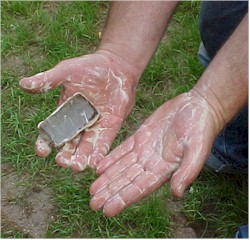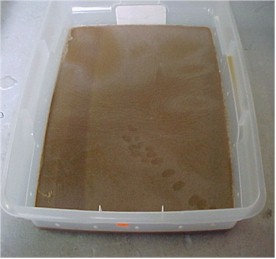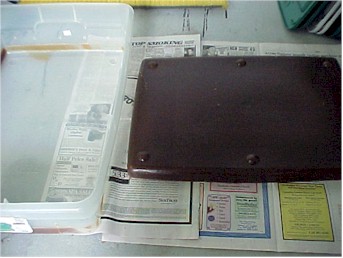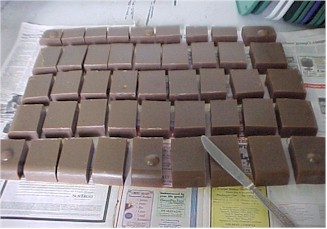A byproduct from making bio-diesel is glycerin. In a process called transesterification, waste vegetable oil (WVO) is broken down into esters (bio-diesel) and glycerin. This glycerin can be filtered to remove any food particles or impurities, and used as an industrial degreaser in its raw form, composted and used as a fertilizer, or made into bar soap. Bar soap made from your glycerin byproduct is excellent for use in the shop because of its degreasing abilities, but can also be used as a household soap for everyday use. Adding fragrances and dyes will make household use more appealing to other members of the household.
 |
|
The soap lathers well and cuts grease and dirt easily. |
Ingredients used in making bar soap from glycerin are, glycerin, water and lye. The amounts of water and lye used will effect the lathering abilities of the soap. I have found that the more water used, the more lather the soap will produce. And using more lye will produce a soap which is very strong and cuts grease well, but also dries out the skin.
To begin, filter the glycerin to remove any unwanted impurities, you may have to heat the glycerin back to a liquid state in order to strain it. A good strainer is a restaurant type strainer used for vegetable oil or an old pair of panty hose works well.
The amount of lye and water used will depend on the amount of glycerin you are processing. I have found that one quart of water per gallon of glycerin (or 25%) works well, producing a soap with good lathering and cleansing abilities. On the lye, I use 38.5 grams per liter or 5.5 oz. per gallon of glycerin. I have used these quantities on several batches of glycerin, even when the glycerin is from WVO from different sources.
 |
|
Plastic “Tupperware” sweater box used to hold soap while cooling. |
Heat the glycerin in a stainless steel or aluminum pot (or your bio processor) to 150 degrees F. to remove any excess methanol (if you used ethanol, heat to 175 F.). Measure the proper amounts of water and lye to be used, heat the water to 100 degrees F., add the lye and mix until all the lye is dissolved. Be sure not to breathe the fumes. Pour the water/lye mixture into the glycerin. Continue to heat the glycerin for another ten minutes while mixing. Allow to mix for an additional ten minutes (20 mins. total) at slow speed. The mixture may foam up slightly and form soap bubbles. After mixing is complete, the soap can be poured into a container and allowed to cool.
A good container to use is a Tupperware type container available at any Wal-mart for a couple dollars. You do not need to add any type of release agent using these type of containers, and removal is simple. You will need two 28 qt. containers for 3 gallons of soap at 1 1/2″ thick. Pour the soap into the containers at the desired thickness and cover with a piece of cardboard or plywood to help hold the heat in, and let set for 24 hrs. As the soap cools, it will start to solidify.
 |
|
The hardend soap easily is removed from the container and is ready to be cut into individual bars. |
After the 24 hr cooling period, the soap should be ready to be removed and cut into bars. Using a butter knife or putty knife, slice around the inside edge of the container to release the soap from the sides. Quickly turn the container upside down over a piece of newspaper or cardboard. You may have to tap lightly on the bottom of the container to help it release and drop out. You now have a nice evenly shaped “slab” of soap which can be cut into individual bars. Each slap will produce about 45 bars of soap measuring 2″ X 3″ each.
 |
|
Lay the bars of soap on a piece of waxed paper or newspaper to allow for further drying. |
Allow soap to set in a cool area for approximately 4 – 7 days before using. When first cut the soap will appear dark in color, but will lighten to a tan color as drying progresses. The resulting soap is a long lasting bar with good cleansing abilities leaving no greasy residues.
Soap can be stored in plastic zip lock bags or placed in plastic tubs in layers with waxed paper in between each layer and kept in a cool place.

